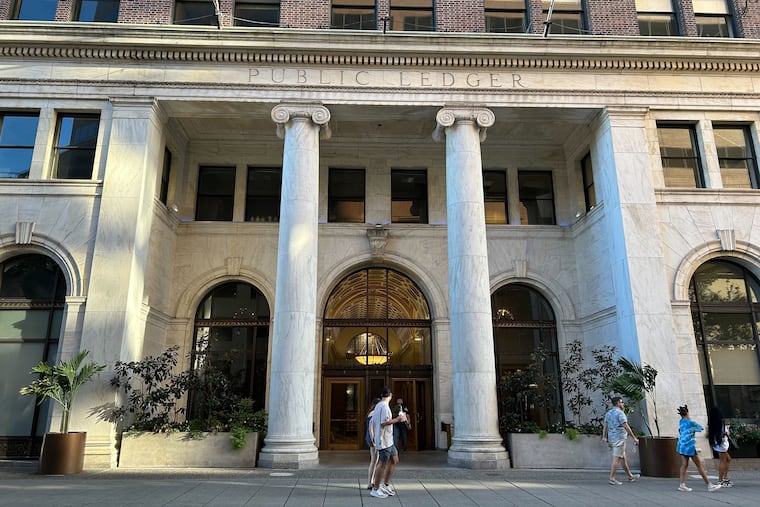Offices in the Public Ledger building may be converted into apartments
Building permits reflect a proposal for 265 apartments and amenity space for the tenants.

The New York-based owners of the western side of the Public Ledger building are considering converting much of the office space to multifamily rental housing.
The ground-floor offices that the Center City District currently occupies is the only portion of the part of the building owned by Baycrest Properties & Management not being contemplated for apartments or tenant amenities.
“The building is in good shape. The sense that the owners have is that this would be an asset to the community and might make the building more part of the community if it was more occupied,” said Jerry Roller, principal with JKRP Architects of Philadelphia, which has been working for Baycrest on conversion possibilities.
Roller emphasized that the permits for 265 apartments are not a definite or final proposal. He said that JKRP has conducted a couple studies of conversion for this portion of the Public Ledger building, but they haven’t gone further yet.
The owner “wants options in terms of what to do with the building. Office leasing is struggling, and he’s looking at other options,” Roller said. “There are a number of residential options around Washington Square that seem to do pretty well. That’s why he took that permit because it gives him a possibility of doing something else.”
The owner of Baycrest’s portion, Shia Strum, did not respond to a request for comment.
The historic structure that fills the city block between Chestnut and Sansom and Sixth and Seventh Streets is carved into multiple condominium units. Baycrest purchased the western side of the Public Ledger building in 2018 for $32 million.
Wawa owns its space at the northeast corner facing Independence Hall. The rest of the eastern section is owned by the Carlyle Development Group of Purchase, which converted much of its portion to residential prior to the pandemic.
Baycrest’s permits note that the residential rental units would be placed in floors two through 10, and on portions of floors 11 and 12. The rest of those two upper floors will be used for “resident amenity spaces” that would go where there currently are historic ballrooms.
Some tenants still occupy spaces on the upper floors, but like many older office buildings in the city, the Public Ledger has struggled with vacancy issues since the pandemic.
“I’m told they are having challenges in fully leasing,” Roller said.
Historic office buildings like 150 S. Independence Mall are prime targets for this kind of office-to-residential conversions because they have smaller floor plans, which allows future tenants more access to windows and light.
“These buildings are perfect for that because they’ve got these giant windows, great archways for lobbies, and the ornate finishes are really nice,” said Paul Levy, president of the Center City District, a business leadership organization.
Philadelphia has a track record of such historic building conversions, which is part of the reason there have been few other major proposals to turn beleaguered offices into apartments: many of the easiest projects have already been finished.
The only other major example of a possible conversion post-2020 is the Alterra Property Group’s proposal to convert 1701 Market St. into a 325-unit apartment building. The developer pulled permits for the project in July.
That structure is currently fully occupied by the law firm Morgan & Lewis, which is moving west to a new office building at 2222 Market St. The future total vacancy is one of the reasons it attracted multifamily developer attention: Many other struggling office buildings are at least partly occupied and have leases that expire at different times.
Levy said that even though Baycrest’s permits call for the area the Center City District occupies to remain “professional office space,” his organization would likely move to a different space in Center City by the time the conversion is complete.
“Probably in a year from now, we won’t be here,” he said.